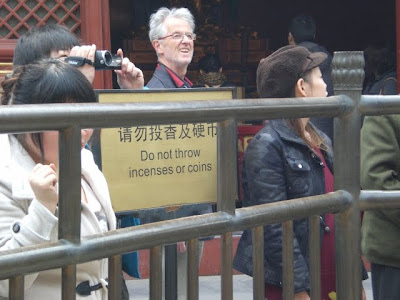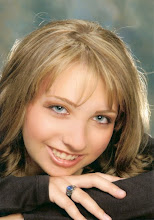For our last day in Beijing we decided to spend the day exploring some of Beijing’s temples. We slept in a little bit, had a relaxing, quiet breakfast, and then took the subway to the Yonghegong Lama Temple.

Although crowded with tourists, we were able to pay for our tickets and then enter the temple. I’m not sure how I feel about charging an entrance fee for a temple, but that’s the way it is in Beijing. If you want to see it, you gotta pay for it.
The Lama Temple was an interesting place, since it is still an active place of worship for practicing monks of Tibetan Buddhism. Many Chinese people were praying with incense, while others were mere onlookers.

However, it was very crowded, and the smell of incense was a bit overwhelming at times. And one thing I noticed at the Lama Temple was a complete disregard for the rules. For example, it is a common practice to throw money at Buddhist statues in prayer, but often you will find signs requesting that people don’t do that. Lama Temple was no different, and even though there was a posted sign saying “Do Not Throw Incenses or Coins,” (in both Mandarin and English, mind you), a huge crowd was gathered around the statue as people aimed to get their coins in the hole at the top of the statue.


There were also many signs requesting no photos be taken. They were very clear at the entrances of the small museum halls, which display precious Buddhist relics. A camera with a circular red “no” symbol was posted at the entrance, but people paid it no mind.
When I went into the main hall, I noticed a sign outside that read “No Film.” I took that to mean that filming with video cameras was not allowed, but that pictures were still okay. I was stunned to see the stunning statue of Maitreya Buddha, which towers over visitors and barely fits in the large hall. In fact, the statue made it into the Guinness Book of World Records since it is made from a single piece of sandalwood and is almost sixty feet tall!

I was lucky to get in a couple of photos, but one of the monks came over and put his palm in front of my camera lens to stop my photography. Apparently, they mean “No Photography,” not “No Film.” Unfortunately, you will often find that sometimes the English on the signs for the tourist spots are unclear or not properly translated.
After the Lama Temple we made our way across the street for the Temple of Confucius. On the way we stopped at a little shop where a man was selling “Beijing Yogurt.” Margarida bought some, and it was quite tasty. The man that ran the shop asked where we were from, and we told him, “Portutal, USA, and Finland.”

Usually people get a little excited when they hear I’m from the legendary United States of America, but this guy didn’t really care. Rather, he was excited to hear that Iris was from Finland, and began reciting numbers in Finnish to her. Of all the languages you’d expect a Chinese man to know, Finnish is definitely not one of them. Finnish in general is a rather obscure language to expect a foreigner to Finland to know anyway, but this man somehow had learned numbers in increments of ten, ten through fifty.
The man was also a little strange, for he had a collection of birds on display outside his shop. There was a green and blue one sitting on a perch right next to the table outside, and he seemed perfectly content despite all the people around.

We finally arrived at the Temple of Confucius, which was originally built in 1302! It was very exciting to be at such an old landmark, even though I was sure it had undergone much renovation over the past 700 years.
I decided I liked the Temple of Confucius much better than the Lama Temple. This temple was dedicated to teaching students of Confucianism back in the day, and I could imagine this place as a great “thinking” spot.

This place had a few display rooms where a number of traditional Chinese musical instruments were on display. One was just a small room, where the other one was a great hall with winding pathways. I saw some displays of Chinese flutes and at last learned the names of them. My hope is to find one and bring it back with me to the US before I return home.

After wandering around the Temple of Confucius, we walked to the Academy next door. This used to be where the students of Confucianism took their exams and attended lectures of great thinkers. This place was a little more crowded, but still a beautiful place to come and sit in the beautiful courtyard.

After spending the day relaxing and wandering around in these amazing temples, we decided to head to the Silk Market. We took the subway to that area, which is in the heart of Beijing, and ate a quick lunch at McDonald’s before we started our exhausting day of shopping.
Before entering the Silk Market there is a sign that says, “Welcome to the Silk Market: The most visited market by foreign tourists!” A tourist would probably think that was pretty convenient and tourist-friendly, and that a lot of the items in there would be marketed specifically for tourists. Perhaps they’d feel even welcome here. But Margarida, Iris, and I knew better, especially after our experience at the Pearl Market. In fact, we groaned when we saw the sign. Prepared to bargain down to the teeth, we entered.
We spent a few hours there shopping. They had some very interesting items, and I found a lot of great souvenirs to send back home. Margarida had to go withdraw some money at the ATM, which just happened to be next to a small, open nail salon. We were handed business cards with the prices on them. When Iris saw the incredibly low price for eyelash extensions, she jumped at the chance, while I rushed in for a USD $6.00 manicure. Margarida said she would meet up with us later and continued her shopping (nail salons aren’t her thing, I guess). : )
We weren’t hungry for dinner, but instead of returning to our hostel to crash for the night we returned to the local market from the night before. Margarida had some more things she wanted to go back for, so we took the subway back and shopped some more. Iris and I saw beautiful Chinese-style dress and shirts for cheap, but we didn’t have any more money left. We decided to return the next morning after stopping at the ATM after breakfast. The plan was to get up early so we could make it to the market before checking out of our hostel.
There was a boy about our age that worked at the shop with the silk dresses, and the four of us got to talking. He was really eager to talk about our countries with us, and he was a really nice guy that I enjoyed talking to. However, the older woman that ran the shop kept interrupting us by throwing new items in our faces, which was irritating! I felt bad for the poor guy, because he really wasn’t too interested in selling us stuff anymore, not after we’d already bought plenty. It was nice to be reminded that there are actually some good people in Beijing that aren’t trying to take advantage of Westerners for their money.
After shopping we took the subway back to our hostel. Because I was tired of our hostel’s freezing shower, I decided to wait until after my flight the next day, when I was back in the familiarity of my own apartment.
Coming up next, the last installment of my Beijing journey, “Beijing: Day Seven.”
Kati

No comments:
Post a Comment